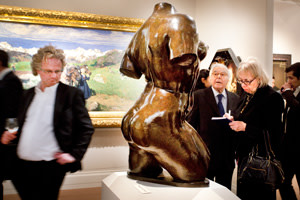Sotheby’s agrees to return 10th-century Cambodian statue

Roula Khalaf, Editor of the FT, selects her favourite stories in this weekly newsletter.
After a two-year legal battle, Sotheby’s has agreed to return a 10th-century sandstone statue that was pillaged from the Koh Ker temple complex deep in the Cambodian jungle in the 1970s.
The 500lb statue, the Duryodhana, was sent for sale in 2011 by Decia Ruspoli di Poggio Suasa, who had owned the piece since it was bought from Spink in London in 1975. Sotheby’s valued the statue at $2m-$3m and it was put on the cover of an antiquities sale in New York.
However, the statue was quickly withdrawn from sale when it became the subject of a federal US lawsuit, with prosecutors seeking its forfeiture on the grounds that it had been looted from Cambodia and illegally imported into the US.
Now the case has been resolved, with Sotheby’s agreeing to pay to send the statue back to representatives of the kingdom of Cambodia in New York. Ruspoli will not receive any compensation, and the court decided that there was a “good faith disagreement” over whether both the owner and the auction house knew of the statue’s true provenance. “Further litigation would be burdensome,” US attorney Preet Bharara concluded.
This should encourage the return of a second statue, Duryodhana’s twin, which is now in the Norton Simon Museum in Pasadena, California: officials are now expected to travel to Cambodia to discuss this. The institution bought the statue in 1976 from the now-deceased New York dealer William Wolff.
…
Artnet, one of the longest-established visual arts websites, sells art at auction, offers a platform to art dealers and runs the leading art prices database. Now it has bold new plans for the future.
The website, which is quoted on the Regulieter Markt in Frankfurt, has been having a tumultuous time. Last year Jacob Pabst replaced his father, Artnet founder Hans Neuendorf, as chief executive. In the same year the site lost over $3m and closed down its 16-year-old online art magazine along with its Paris office, and fought off a hostile takeover from the Russian-backed Redline Capital after a dramatic and rowdy 13-hour shareholder meeting.
Now Pabst has hired Ben Genocchio, former editor-in-chief of Art+Auction magazine, away from Louise Blouin Media to set up Artnet News, a 24-hour news service covering Europe, Asia and America. Pabst says it will be the “Bloomberg of the art world”. It will be put in place gradually, he says, with Genocchio hiring reporters around the world, but will launch in February and will be fully in place by the end of 2014. At the same time, Artnet will completely redesign its now ageing website.
Asked how he will finance the expansion, Pabst says: “I am asking myself the same question, but we have a business plan and I have found a good and safe way to do it; we expect to increase revenue through advertising and we can always inject cash.”
Essentially, this means that Neuendorf, who remains the main shareholder, will continue to prop up the company – in March this year he gave $641,000 to Artnet.
But while Artnet is hiring, others are firing. Blouin Media – which runs the website artinfo.com, as well as a price database and magazines such as Art+Auction and Modern Painters, initially also had the ambition of being the “Bloomberg of the art world”. Now, however, it has just terminated the contracts of 25 freelance journalists around the world – though it told the New York Observer that it is not curtailing its international coverage.
Bloomberg itself has closed its Muse section, which covered culture and arts, folding it into a new “Luxury” section and leading to some job losses. It seems that it’s only Bloomberg who doesn’t want to be the Bloomberg of the art world.
…
Shake-ups continue at the two main auction houses. Just two weeks after Tobias Meyer departed from Sotheby’s, Christie’s Amy Cappellazzo announced that she was leaving to found a “private venture”, confirming the rumour that had been swirling around New York for some time. Cappellazzo had been a powerhouse in developing private sales and the internet. Where is she going? She says she will “soon embark on a private venture aimed at fully serving the needs of collectors in today’s changing art market”.
…
Still on the subject of Sotheby’s and Christie’s, both are bulking up their marketing prowess with new hirings. Christie’s has taken on Marc Sands from Tate, where he developed the brand and was responsible for the digital activity – an area in which Christie’s is heavily invested. Sands’ main task will be to “inspire and engage the growing audience for art,” says the auction house’s chief executive Steve Murphy.
Sotheby’s, meanwhile, has recruited veteran marketeer and brand specialist Alfredo Gangotena, as chief marketing officer. Gangotena has just left MasterCard and has experience at other brands such as Procter & Gamble and Disneyland Paris. He will become what Sotheby’s describes as its “brand steward”. It has also recruited another luxury goods guru, Domenico De Sole, as lead independent director on its board. De Sole is chairman of Tom Ford International and former head of Gucci, which he helped to change from family business into the global conglomerate it is today.
…

No surprises here: the projected link-up between Sotheby’s and The European Fine Art Fair to create a Chinese version of the Maastricht event has collapsed. The high-end Tefaf Beijing was planned for autumn 2014, with Tefaf choosing the galleries and Sotheby’s supplying the all-important licence through its partnership with the state-owned GeHua. But the proposals were not enough to convince Tefaf dealers, who remain sceptical about just how ready the Chinese are to buy in many of the fields they specialise in. The door is left ajar, however, as Tefaf has merely stated that the fair “is not viable at the present time”.
Georgina Adam is art market editor-at-large of The Art Newspaper
Comments